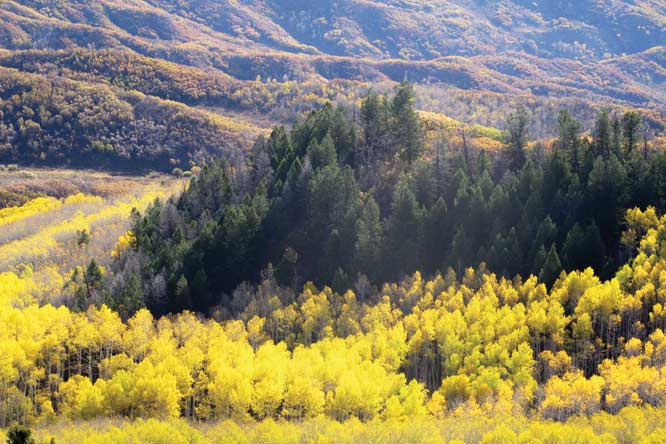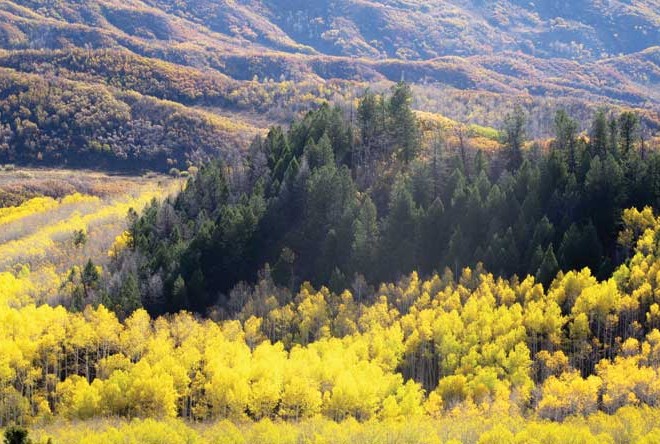By Alissa Johnson
Editor’s Note: In this summer series, reporter Alissa Johnson looks at the big picture of oil and gas development in Gunnison County. Last week, we looked at trends in the discussion around oil and gas. This week, in the final installment, we look at how the county regulates oil and gas development and the conclusions we can draw about the current conversation.
Gunnison County has been permitting oil and gas development since 2001, but in the beginning, the review process was not specific to oil and gas. The Community Development Department and the Planning Commission considered proposals under the county’s Land Use Resolution, which guides land development in the unincorporated parts of the county.

But as county attorney David Baumgarten points out, the document wasn’t created with mineral extraction and exploitation in mind—it was designed for real estate development. In 2003, the county developed oil- and gas-specific regulations based on the philosophy that oil and gas deserve to be developed, but not at the expense of the environment and natural resources. And, fittingly so for Gunnison County, the approach was anything but typical.
“Most regulations, whatever you’re regulating, do it in what is called a prescriptive manner,” Baumgarten explained. “Prescriptive regulations will tell you that you can have so much weight or height or cubic inches or setbacks. Oil and gas, because it’s in the ground over different types of terrain and surroundings, doesn’t lend itself to those prescriptive measures. We went about it in a different fashion.”
The county developed what are known as performance regulations, outlining a set of outcomes that it wanted to see—such as no adverse affect on water, air, neighbors or noise—and leaving it to the oil and gas companies to demonstrate that they would not violate them.
“It’s a very unusual way to do regulations, but it is one that gives credit to the industry for knowing its industry and allows expansion over different types of geography,” Baumgarten said.
continued from page 1
The approach turned out to be important, as it didn’t take long for the regulations to lead to lawsuits and the contention that local governments had no place in the regulation of oil and gas development.
Claiming the right to regulate
According to Baumgarten, when the county published its oil and gas regulations all was well—for a time. And then BDS International, a company that no longer operates in the area, drilled a well without going through the county’s regulatory process. In response, Gunnison County sued. And on the witness stand, the company’s president said he’d made a business decision: A lawsuit would be cheaper than complying with regulations.
The case became even more notable when the state of Colorado joined the lawsuit on the side of BDS, asserting that a local government had no authority to regulate oil and gas because of preemption, a theory that suggested the state already regulated oil and gas, and because it was a statewide regulating entity there was no room on the “playing field” for a local government like Gunnison County.
“Our theory was quite different,” Baumgarten said. The county argued that local regulations could be applied harmoniously with other regulators—an argument that it lost in district court. But in the court of appeals, things took a turn.
“The court agreed with the argument that the harmonious application of regulations met the standard already demonstrated by the Colorado Appellate Court,” Baumgarten said.
In laymen’s terms: The court upheld the regulations.
Becoming an example for local involvement
Over the years, oil and gas company SG Interests sued the county twice over its oil and gas regulations. Both times, the court upheld the majority of the regulations, and the state stayed out of the lawsuits. While that was good for Gunnison County, the county’s success also had the potential to become a point of contention.
As the oil and gas debate heated up on the Front Range, cities and counties there became educated by what they saw happening in Gunnison. When the state suggested that these Front Range communities had no local authority to regulate oil and gas, they pointed to Gunnison County to suggest otherwise.
Looking to maintain a positive relationship with the state, county representatives sought to change the conversation. Rather than debate the county’s authority to regulate and inspect development projects, they worked with the state to negotiate a new kind of partnership.
One of the initial benefits of that new partnership was that the county would select and hire an inspector, and that inspector would be state-certified and conduct state inspections within Gunnison County. It was a win-win—the county could inspect wells and well pads, and the state could rest assured that its standards were being monitored too.
“Before [the companies] turn a spade of earth all the way through production—so as they’re putting a well in the ground—we can have an inspector on site to inspect for not only our conditions but for the state conditions as well,” Baumgarten said.
The partners formalized the arrangement—including Gunnison County’s intent to fully participate in available state processes—with an intergovernmental agreement in 2012, and it has been working quite well since. Baumgarten says the state has even begun to point to Gunnison County as a model for local government involvement.
“We have had no more lawsuits with the state and really began to have a strong, beneficial relationship where we communicate with each other,” Baumgarten said.
Public involvement and changes in the industry
When an oil and gas company wants to drill in Gunnison County, it files an application for a permit to drill (APD) with the Colorado Oil and Gas Conservation Commission (COGCC). It also applies for a permit with the county. According to Neal Starkebaum, the county’s assistant director of community development, companies typically file an APD and then come to the county, though there’s no requirement to do one before the other.
Depending on the type of project, county staff or the Planning Commission evaluate the proposal under the oil and gas regulations. Whereas oil and gas development initially drew a high level of public attention, from Starkebaum’s seat in public meetings, fewer people are providing input.
“Early on, 10 years ago, we had very large turnouts at the Planning Commission, particularly at public hearings for some of the larger projects,” Starkebaum said. These days, High Country Conservation Advocates and Citizens for a Healthy Community are regularly in attendance—a good thing, Starkebaum believes—but the number of citizens attending meetings or submitting comments doesn’t seem as high.
“Even on the last set of applications for a water storage facility on the Spadafora, not many people showed up. We did not have a packed meeting room,” Starkebaum said. That, he hopes, stems in part from there not having been a lot of problems with oil and gas development in Gunnison County. He also noted that the industry has evolved significantly over the last decade to result in less disturbance.
“There has been an evolution in the industry to be somewhat more environmentally sensitive. It’s still an intensive use, as is any mineral exploration and extraction,” Starkebaum said.
Water storage and the reuse of water has cut down on the number of truck trips (which could otherwise number in the hundreds) and horizontal drilling has made it possible to have as many as six to eight wells on a single pad. Companies also have the technology to survey land and identify well pad sites that require the least amount of surface disturbance.
In addition, Colorado banned the use of diesel fuel in fracking fluids and the types of products used for fracking are now disclosed. “Those changes have caused a quantum leap in the elimination of environmental surface disturbance, the amount of roads and certainly the amount of traffic and the use of water. They are significant advances,” said Starkebaum.
The current conversation
Of course, as Starkebaum also noted, a decline in public participation does not equate to a lack of interest. People are still concerned about fracking, and it’s among the people closest to the debate about where and how to develop that the shape of the current conversation becomes clear.
Roger Cesario owns 1,400 acres of land split among five parcels in the North Fork region, and in some cases surrounded by oil and gas development. One parcel is located near the water storage facility mentioned above, and another is in the western part of the Muddy Creek area, where Gunnison County’s oil and gas development is concentrated.
Cesario’s ranch has been in his family since 1929, and his property has been commercially hunted since the 1960s. A cabin in Sheep Park is located on elk calving grounds—Cesario has seen an elk calve 100 yards from his door. It makes sense, then, that wildlife values are his biggest concern. And yet Cesario has not taken a stance against development. Oil and gas companies lease 300 acres from him, and he is currently in additional negotiations.
continued on page 16
continued from page 12
For Cesario, those conversations have become a way to help balance development with conservation, whether that’s considering allowing oil and gas companies to use his road to access wells on federal lands or going so far as to consider the placement of wells on his land so they can be less intrusive of view corridors.
“It takes a tremendous amount of time,” Cesario says, pointing out that most ranchers and landowners are inexperienced with the process. Getting involved requires getting educated and getting up to speed fast.
Yet for Cesario, it doesn’t seem to be optional. As he sees it, oil and gas development isn’t a question, it’s reality. And in his experience, some government agencies have left a vacancy in the conversation when it comes to protecting wildlife.
“We shouldn’t sacrifice an area because oil and gas development is occurring,” Cesario said. “There are ways to protect wildlife values, keep recreation viable and have resource extraction. Finding that balance is key.”
That desire to balance development with conservation and protection can also be heard among the groups working to protect some areas from development altogether. Tim Brass is a state policy manager for Backcountry Hunters & Anglers, and his organization has been working to identify areas suited for protection as part of a public process initiated by Senator Michael Bennet. Working with local sportsmen, outfitters and others, Brass helped develop a map highlighting areas for protection that he hopes will be considered as part of a broader approach to development.
“We think something in between that gives the oil and gas companies some of what they want and also gives the conservation community some protection in return is a good approach,” Brass said.
In fact, this sentiment seems to be at the heart of the oil and gas discussion. It’s a conversation being held by community stakeholders, lawmakers, and oil and gas companies, and while disagreement and charged emotions abound, the biggest take-away may be that no one is talking about whether oil and gas development ought to take place. Its existence is a given.
Everyone is talking about how to go about development in order to maintain the natural beauty and vitality of the North Fork Valley and surrounding areas. How development takes place is influenced by many factors, market forces, industry practices, and government regulation among them. But it is also being shaped and moved by people who rise to the occasion simply because their livelihoods and recreational passions come into direct contact with development.
They know what the rest of us need to know, too: The conversation about how development occurs might just be the most important conversation yet.
 The Crested Butte News Serving the Gunnison Valley since 1999
The Crested Butte News Serving the Gunnison Valley since 1999



